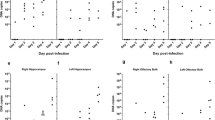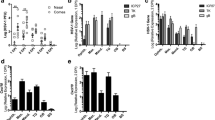Summary
The development of the inflammatory response within the brain, meninges and cerebrospinal fluid (CSF) compartment has been studied for the first time simultaneously in experimental herpes simplex virus (HSV) encephalitis after inoculation via the cornea. Two major viral pathways were found from the eye to the brain: one through the trigeminal nerve to the brain stem and one through the nasolacrimal duct to the olfactory system. Viral antigen was found to be present in the CNS before there were clinical signs or cellular infiltration of brain tissue. Subsequently, the virus spread to all parts of the trigeminal brain stem complex. This phenomenon was accompanied by severe inflammation of the meninges covering the trigeminal root near its entry into the brain stem. The meninges near the entry of the olfactory fila also contained antigen. However, HSV-1 did not spread along meningeal rami of the trigeminal nerve and, consequently, is — at least in this experimental model — not a route to reach the inferior frontal and temporal lobes. The development of CSF changes followed the histopathological development of meningitis and encephalitis closely. HSV-DNA could be detected in the CSF from day 4 post inoculation (p.i.) and HSV-1-specific immunofluorescence in CSF cells was convincingly present on day 5 p.i.; on the same days (4 and 5 p.i.) inflammatory cells were found in apposition to infected cells in the brain. We postulate that HSV is carried to the CSF by infected leukocytes rather than a direct spread to the CSF by simple extension of the encephalitic process to the meningeal surface. Consequently, the chances of detection of viral antigen in CSF cells or HSV-DNA by polymerase chain reaction in CSF at an early, pre-encephalitic stage of disease are slight. The relevance of the findings to the pathogenesis and diagnosis of human herpes simplex encephalitis is discussed.
Similar content being viewed by others
References
Aurelius E, Johansson B, Sköldenberg B, Staland A, Forsgren M (1991) Rapid diagnosis of herpes simplex encephalitis by nested polymerase chain reaction assay of cerebrospinal fluid. Lancet 337: 189–192
Boerman RH, Peters ACB, Verhey M, Raap AK, van Ekdom LTS, van Eer A, van der Ploeg M (1988) Immunofluorescence detection of herpes simplex virus type 1 antigen in cerebrospinal fluid cells of experimentally infected mice. J Neurol Sci 87: 245–254
Boerman RH, Arnoldus EPJ, Raap AK, Bloem BR, Verhey M, van Gemert G, Peters ACB, van der Ploeg M (1989) Polymerase chain reaction and viral culture techniques to detect HSV in small volumes of cerebrospinal fluid; an experimental mouse encephalitis study. J Virol Methods 25: 189–198
Boerman RH, Arnoldus EPJ, Peters ACB, Bloem BR, Raap AK, van der Ploeg M (1991) Polymerase chain reaction for early detection of HSV-DNA in CSF. An experimental mouse encephalitis study. J Med Virol 33: 83–88
Coleman RM, Bailey PD, Whitley RJ, Keyserling H, Nahmias AJ (1983) Elisa for the detection of herpes simplex virus antigens in the cerebrospinal fluid of patients with encephalitis. J Virol Methods 7: 117–125
Cook ML, Stevens JG (1973) Pathogenesis of herpetic neuritis and gangliomitis in mice. Evidence for intra-axonal transport of infection. Infect Immun 7: 272–288
Davis LE, Johnson RT (1979) An explanation for the localization of herpes simplex encephalitis? Ann Neurol 5: 2–5
Dyson H, Shimeld C, Hill TJ, Blyth WA, Easty DL (1987) Spread of herpes simplex virus within ocular nerves of the mouse: demonstration of viral antigen in whole mounts of eye tissue. J Gen Virol 68: 2989–2995
Fleming JO, Ting JYP, Stohlman SA, Weiner LP (1983) Improvements in obtaining and characterizing mouse cerebrospinal fluid. J Neuroimmunol 4: 129–140
Hebel R, Stromberg MW (1976) Anatomy of the laboratory rat. Wiliam and Wilkins, Baltimore
Johnson GD, Davidson RS, McNamee KC, Rusell G, Goodwin D, Holborrow EJ (1982) Fading of immunofluorescence during microscopy: a study of the phenomenon and its remedy. J Immunol Methods 55: 231–242
Kit S, Kit M, Qavi H, Trulka D, Otsuka H (1983) Nucleotidesequence of the herpes simplex type 2 (HSV-2) thymidine kinase gene and predicted amino acid sequence of thymidine kinase polypeptide and its comparison with the HSV-1 thymidine kinase gene. Biochem Biophys Acta 741: 1350–1354
Koskiniemi M, Vaheri A, Taskinen E (1984) Cerebrospinal fluid alterations in herpes simplex encephalitis virus Rev. Infect Dis 6: 608–618
Kristensson K, Vahlne A, Persson LA, Lycke E (1978) Neural spread of herpes simplex virus types 1 and 2 in mice after corneal or subcutaneous (footpad) inoculation. J Neurol Sci 35: 331–340
Martin JR, Suzuki S (1989) Targets of infection in a herpes simplex-reactivation model. Act Neuropathol 77: 402–411
Rowley AH, Whitley RJ, Lakeman FD, Wolinsky SM (1990) Rapid detection of herpes-simplex virus DNA in cerebrospinal fluid of patients with herpes simplex encephalitis. Lancet I: 440–441
Spaar FW (1970) Die menschlichen Herpes-Simplex Encephalitis und Meningitis. Gustav Fischer Verlag, Stuttgart New York, pp 51–62
Tomlinson AH, Esiri MM (1983) Herpes simplex encephalitis. Immunohistological demonstration of spread of virus via olfactory pathways in mice. J Neurol Sci 60: 473–484
van Loon AM, van der Logt JTM, Heessen FWA, Postma B, Peeters MF (1989) Diagnosis of herpes simplex encephalitis by detection of virus-specific immunoglobulins A and G in serum and cerebrospinal fluid by using an antibody-capture enzymelinked immunosorbent assay. J Clin Microbiol 27: 1983–1987
Author information
Authors and Affiliations
Additional information
Supported in part by the “Stichting Prof. AAH Kassenaar Fonds”, Faculty of Medicine, University of Leiden
Rights and permissions
About this article
Cite this article
Boerman, R.H., Peters, A.C.B., Bloem, B.R. et al. Spread of herpes simplex virus to the cerebrospinal fluid and the meninges in experimental mouse encephalitis. Acta Neuropathol 83, 300–307 (1992). https://doi.org/10.1007/BF00296793
Received:
Accepted:
Issue Date:
DOI: https://doi.org/10.1007/BF00296793




